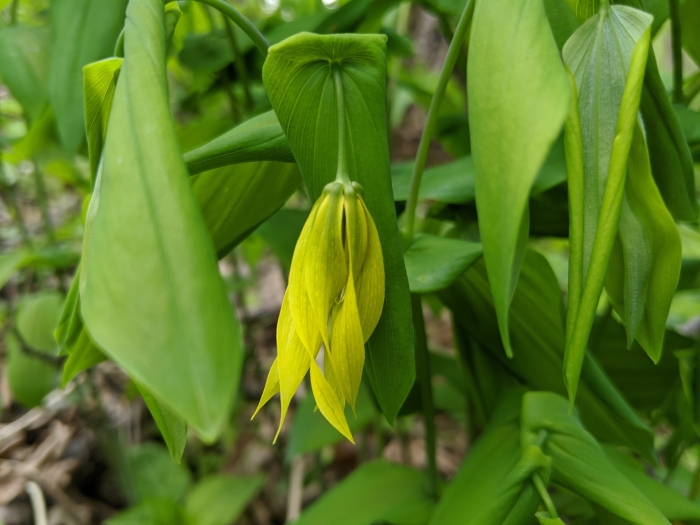Large-Flowered Bellwort
(Uvularia grandiflora)
Large-Flowered Bellwort (Uvularia grandiflora)
/
/

Sarah DeLong-Duhon
CC BY 4.0
Image By:
Sarah DeLong-Duhon
Recorded By:
Copyright:
CC BY 4.0
Copyright Notice:
Photo by: Sarah DeLong-Duhon | License Type: CC BY 4.0 | License URL: http://creativecommons.org/licenses/by/4.0/ | Rights Holder: Sarah DeLong-Duhon | Publisher: iNaturalist | Date Created: 2020-05-07T13:22:07-07:00 |




















































Estimated Native Range
Summary
Uvularia grandiflora, commonly known as Large-Flowered Bellwort, is a deciduous perennial herb that thrives in the understory of rich, deciduous forests and along the edges of wooded areas in the Eastern and Central United States, as well as Southeast Canada. It typically grows to a height and width of 2 feet (0.6 meters), featuring arching stems and lance-shaped leaves that are hairy on the undersides. The plant is noted for its nodding, bell-shaped, yellow flowers that appear in mid- to late spring, which are large, solitary or paired, and quite showy. The flowers’ graceful droop is due to the weight of the leaves and blooms, giving the plant a distinctive appearance.
Large-Flowered Bellwort is valued for its subtle beauty and ability to add a naturalistic feel to shaded garden areas. It is often used in woodland gardens, naturalized areas, or as a ground cover in shady spots. The plant’s preference for part shade to full shade, medium water requirements, and tolerance for slow to medium-draining soils make it a versatile choice for gardeners with shaded landscapes. It is also appreciated for its ecological role, as its seeds, which are dispersed by ants, contribute to forest regeneration. However, gardeners should be aware that deer find this plant particularly palatable and may browse it heavily. To mitigate this, protective measures may be necessary in areas with high deer populations.CC BY-SA 4.0
Large-Flowered Bellwort is valued for its subtle beauty and ability to add a naturalistic feel to shaded garden areas. It is often used in woodland gardens, naturalized areas, or as a ground cover in shady spots. The plant’s preference for part shade to full shade, medium water requirements, and tolerance for slow to medium-draining soils make it a versatile choice for gardeners with shaded landscapes. It is also appreciated for its ecological role, as its seeds, which are dispersed by ants, contribute to forest regeneration. However, gardeners should be aware that deer find this plant particularly palatable and may browse it heavily. To mitigate this, protective measures may be necessary in areas with high deer populations.CC BY-SA 4.0
Plant Description
- Plant Type: Herb
- Height: 1.5-2 feet
- Width: 1-1.5 feet
- Growth Rate: Moderate
- Flower Color: Yellow
- Flowering Season: Spring
- Leaf Retention: Deciduous
Growth Requirements
- Sun: Part Shade, Full Shade
- Water: Medium
- Drainage: Slow, Medium
Common Uses
Bank Stabilization, Bee Garden, Border Plant, Drought Tolerant, Low Maintenance, Potted Plant
Natural Habitat
Rich, deciduous forests and woodland edges
Other Names
Common Names: Great Merrybells, Large Flower Bellwort, Guldrams, Large-Flower Bellwort
Scientific Names: , Uvularia grandiflora, Uvularia grandiflora f. grandiflora, Uvularia grandiflora f. latifolia, Uvularia grandiflora f. rotundifolia, Uvularia grandiflora f. variegata,
GBIF Accepted Name: Uvularia grandiflora Sm.